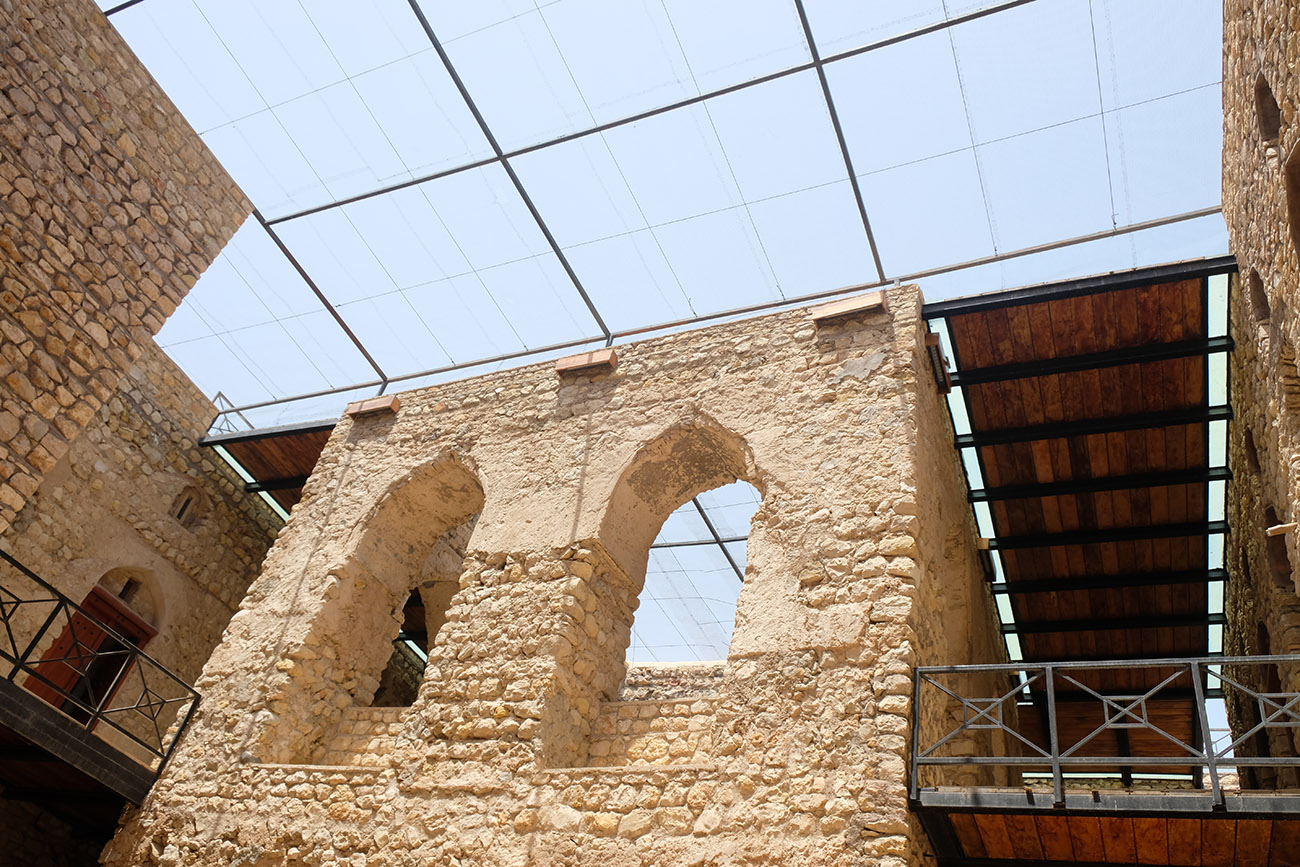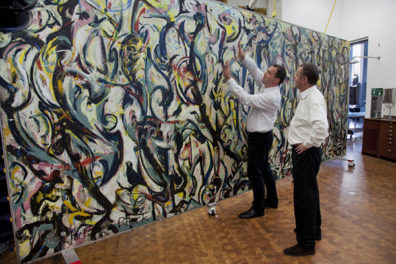
Eithar Alhasni (crouching at right) works with other participants in the earthen architecture course to complete a field exercise about the density versus moisture content of different types of raw earth, which determines the conditions in which they should be used.
People across the world have used earth, clay, and other such materials to construct buildings for thousands of years, from ancient times to today. These earthen structures exhibit a huge variety in size and style.
Training opportunities in best practices of earthen architecture conservation, especially those addressing earthen architecture in the Middle Eastern, North African, and South Asian regions, are greatly lacking. A monthlong course held in October 2018 in the World Heritage City of Al Ain in the Emirate of Abu Dhabi was a rare opportunity for professionals to spend four weeks immersed in the conservation of earthen architecture. (See highlights from the course on YouTube.) Organized by the Getty Conservation Institute and the Department of Culture and Tourism–Abu Dhabi, the course brought together architects, engineers, archaeologists, and conservators from the regions of the Middle East, North Africa, and South Asia responsible for the care of earthen structures to further their knowledge in current best practices and help build a global network of experts.
Early in the course Angela spoke with several participants to hear about the particular challenges they face back home in working with earthen architecture and what they hoped to learn from the course. Each cast light on the diversity of earthen building techniques and types and the specific conservations issues they face, as well as on their shared sense of the urgency and importance of this work for preserving their cultural heritage.
Eithar Alhasni – Ministry of Heritage and Culture, Oman
Eithar Alhasni is an architectural engineer whose study of earthen architecture and architectural history began at university. Today she works for the Ministry of Heritage and Culture in Oman, which was founded in 1975. She works within the ministry’s heritage sector in the Department of Restoration and Maintenance, which undertakes the conservation of built heritage or gives permission for such work.
Why is earthen architecture important to you?
We’ve been taught that architecture reflects the time you’re in. It mirrors who you are and how you live.
In Oman, we had a new government in the ’70s. For political reasons, people left their earthen architecture settlements and moved into modern concrete houses. A lot of knowledge about this heritage was lost with that move, which has led today to a lot of unanswered questions. I believe that if we don’t document and study this heritage now, we will be losing a lot more than we realize.
You mentioned settlements were abandoned. Are there other types of earthen heritage you work with?
The settlements are a relatively new focus for the ministry, something we just became responsible for. Prior to this, the main focus of the ministry was to restore and maintain iconic monuments, which are mostly defensive—forts and castles—and which have patriotic and historical value.

Eithar (in the center) with fellow team members from the Documentation of Omani Historical Settlements project in 2014. Courtesy of Eithar Alhasni
What types of conservation issues are you dealing with in your work?
As I mentioned, a lot of traditional building techniques have been lost. Many of the people who used to build these traditional settlements are dead now and while their children or their grandchildren may still be living, very little knowledge has been passed down. In Oman, we have different tribes, different climates, different settlements,and everyone did their own thing with many different techniques. If we’re very lucky, someone’s still alive to actually explain and tell us: How did you build this? Why did you do it this way?
In the sixteenth and seventeenth centuries, we had very wealthy merchants and very strong connections with India and Africa. These merchants used very expensive materials from those places in their homes, materials that are even more expensive today, which impacts our ability to use them in our restoration work.
We also have questions about craftsmanship. Some of the designs and decorations—we’re not exactly sure what they are made of. This had led us to study these materials to figure out, down to the percent, what they are made of. To do this, we work with the Sultan Qaboos University and other ministries that have the facilities for this research. This will enable us to replicate the designs and decoration when we restore.

One of the projects Eithar’s department has undertaken is the documentation of the historical mosque Masjid Al Jabal (Mountain Mosque). Courtesy of Eithar Alhasni
Are there additional threats to the earthen heritage in your region?
A lot of people don’t appreciate the value of earthen heritage. They believe that concrete modern buildings are the way to go. We have climatic issues that say otherwise. You know, if you live in a concrete block house, and it’s very hot outside, you cannot live in it without air conditioning. It’s like an oven. People don’t realize that.
But the Ministry of Heritage and the Ministry of Tourism have made a lot of effort to encourage people to reinvest in their old homes. Encourage them to relive the culture and history and learn how people used to live in those houses. The success stories actually encourage a lot of people to understand the value of these houses: either to live in them again, to appreciate their grandness—because they’re amazing—or to invest in them for tourism.
So, it’s changing. But it’s a little too slow, maybe a little too late. I hope not.
What limits the impact of your work?
One is the sheer size of our heritage inventory: we have almost 1,100 settlements in a country of 4.5 million people. The ratio of heritage to people is huge. Beyond the earthen settlements, there are the forts, the watchtowers, the schools, and mosques. Finding enough resources, both human and financial, for such a huge inventory is very difficult. We had a five- to six-year-long project just to document the settlements—basic location, name, and size.
What skills or knowledge are you hoping to get from this course?
There have been a lot of “aha” moments for me in these past two weeks. The instructors have been amazing: one is an expert in documentation, another in scanning a building to determine what’s wrong with it. These are areas where we don’t have specialists. Sometimes you don’t know this kind of profession even exists. So being able to connect with these professionals is so valuable. Everyone is willing to help. They’re always open to questions. They’re like true educators.

Eithar (at far right) talks with students from the German University of Technology during their visit to Hujrat Muslamat village in Oman. Courtesy of Eithar Alhasni
Do you have a favorite building?
I do. It is the Fort of Mussana. It’s such an underdog, because nobody really knows about it. It’s a fort by the beach made of mud bricks and stone. It was restored—a joint venture between an Italian professor and an Omani contractor—and they did an amazing job. They kept it very real and very original. The walls are still naked; they didn’t plaster things, you can see the layers beneath. The lighting is also fantastic, and they installed wooden and glass walkways around the site. For me, that’s restoration done right, rather than trying to make it look like it used to be, which is not the point.

The interior of Al Mussana Fort. Courtesy of Eithar Alhasni.
Also, they developed the outside area nicely. The people who live nearby use it for celebrations, bazaars, and fairs. So that is also really good, because one of the problems we have is that we baby the monuments too much. We don’t allow anything to happen to them. Which is not a good thing, in my opinion. I would rather let them be open, let people actually come and do things, and have weddings, and whatever.
To make it a living building?
Right, yes. Spend a little more, maybe, in restoration rather than just keeping it dead, letting it do nothing but look pretty and perfect. That’s my personal opinion.




Comments on this post are now closed.